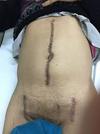Vascular exam - PV exam Flashcards
What might you look for on inspection of the upper limbs in a peripheral vascular exam?
- Skin colour changes
- Ischaemic changes
- Tar-stained fingers
- Tendon xanthoma
- Cap glucose test markings
What would you do on palpation of the upper limbs in a perihipheral arterial exam?
- Temp
- Cap refill
- Pulses - radial, radio-radial delay, radio-femoral, brachial
- Blood pressure in both arms
What might radio-radial delay indicate?
- Aortic dissection/aneurysm
- Proximal coarctation
What might radio-femoral delay indicate?
Aortic coarctation
What difference in BP between both arms would be regarded as significant?
> 10 mmHg
What might a BP difference of > 10 mmHg between each arm indicate as a cause?
- Aortic coarctation
- Aortic dissection
- Subclavian artery stenosis
How might you want to assess the carotid pulse?
- Character
- Auscultate for bruit
What might a carotid bruit indicate?
Carotid artery stenosis
What might you want to look for on the face in a vascular exam?
- Corneal arcus
- Xanthelasma
- Central cyanosis
- Carotid pulse
What might you look for on the abdomen in a vascualr examination?
- Body habitus
- Scars
- Visible aortic pulsation
- Palpate for abdominal and femoral bruits
- Auscultate for bruits
What might a machine bruit on auscultating the abdomen indicate?
AAA
What might you look for on inspection of the lower limbs in a vascular exmination?
- Skin colour
- Ischaemic changes
- Trophic changes
- Muscle wasting
- Ankle oedema
- SCars
What are trophic changes?
- Shiny skin
- Hair loss
- Thin skin
- Ulcers
What might you do when palpating the lower limbs as part of a peripheral vascular exam?
- Temperature
- Cap refill
- Pulses - Femoral, Popliteal, PT, DP
- Squeeze the calves
- Check sensation
What special test would you consider doing in someone as part of a peripheral vascular exam?
Buerger’s angle - and filling/reperfusion time
How long should you hold a patients straight leg in the air for buerger’s test?
30 seconds
What is regarded as a positive buerger’s test?
- Watch their feet for 2-3 minutes
- Pallor followed by reactive hyperaemia on dependency - implies significant PVD
What is buerger’s angle?
Angle at which hip is flexed for 30 seconds which leads to a pale foot.
What other things would you do to complete a peripheral vascular exmination?
- CVS exam
- Neuro motor and sensation exam
- Doppler ultrasound - asssess pulses
What scars might you see on an abdomen for an aortobifemoral bypass?
- Midline laparotomy
- Bilateral groin scars

What procedure may have been done in the following patient?

Aortobifemoral bypass
Where might scars be for an axilobifemoral/axillofemoral bypass be?
- Axillary scars
- Unilateral/bilateral groin scars

What scars might indicate a femorofemoral bypass?
Bilateral groin scars

How would you perform ABPI?


